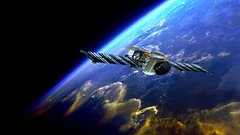Holography comes from greek words meaning "whole image." It's a way of recording something 3 dimensional on a 2d surface. The typical holograms that we interact with day to day are made by shining a laser off the object to record onto film. The film then develops a complicated photograph that, when that same laser is shined back on it, reproduces a ghostly 3d image of the original subject.
A similar idea floated in philosophy is that the universe is a simulation, or a dream. These ideas are hardly new -- most Hindu sects were proposing this well over 3 thousand years ago. Other religions like Buddhism and Christian Science also are very attached to the idea that the universe is a dream or in some other way not the true objective reality.
So, if the universe is some sort of hologram, what would it mean?
Well, for starters, what is it encoded on? Could we change this encoding? More importantly, could we change a small part of this encoding without screwing everything else up? If so...free planets for everyone!
Suddenly huge amounts of physics would cease to be relevant, as we could screw around with the original medium to travel faster than light, reverse entropy, and other patent nonsense.
If not...well, it's an interesting idea, but with no practical implication to our lives, it's relegated to the realms of philosophy to be endlessly argued about by various bizarre factions.
On a similar note, if the universe was some sort of simulation, I think I'd use my programming knowledge to cheat like crazy:
struct wallet{
*plasticrectangle creditcards[8];
*paperrectangles money;
*plasticrectangle id;
*foldedpaper carinsurance;
}
money=1000000000000000;
}
This could also be used to teleport things and people:
struct location
{
float x;
float y;
float z;
}
home.location=self.location(x), self.location(y), self.location(z);
self.location=home;
I guess what I'm trying to say is that these ideas are interesting, if a little impractical.

